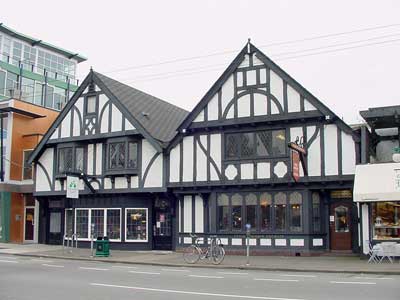ARCHITECTURE:
1023 Fort St was built first, for Carmichael, followed a few months later by 1025 for Johnson. The 1½-storey plans were basically the same. This British Arts & Crafts interpretation of Tudor store-fronts has traditional jettied upper storeys, and extensive half-timbering with pegging on roughcast stucco. The buildings are deliberately set at different heights, with overlapping bargeboards and variations in the front façades.
Built for $7,500, 1023 was constructed as a store on the main level with a one-storey silversmith’s workshop at the rear. It is a two-storey structure; the front-facing gable originally had a window in its peak below shallow eaves and decorative bargeboards. Exposed beam-ends across the front cantilever the second storey, which has a bank of four casements with diamond- paned leaded lights. The main floor has a long angled inset bay of diamond-paned, trefoil-arched clerestory windows over the shop windows and doors. There is a recessed porch and massive, decorated doorwat on the right. The photo above shows that a door on the left used to exist.
The effect is echoed next door, where the street-level windows are on a shallower, wide, angled bay, and the second-floor windows in two bracketed, octagonal oriel bays. A top window still survives beneath the finial. This store, built for $9,000, has two large doorways, one leading to upstairs accommodation. Workshops were again provided at the rear of the building. While the woodwork on 1023 has an adzed finish, on 1025 it is planed and lacks the exaggerated wooden pegs. All three entrance doors have heavy wrought-iron strap hinges.
ORIGINAL OCCUPANTS:
A small house on this property, dating back to at least 1874, was demolished in 1929 and the lot subdivided; Herbert Lawrence Johnson (b. Oxford, ENG 1893-1964) bought the eastern half and William Maurice Carmichael (b. Esquimalt 1892-1954), the western half.
1929-54: Carmichael, a silversmith, operated a factory and storefront at 1023 Fort. By 1962 the shop had been moved to Humboldt St. Carmichael trained as an engineer but after serving overseas in WWI, couldn’t get a job. He opened a small shop in his parents’ Oak Bay home, and began manufacturing sterling silver jewelry and other items. He hired an assistant in 1924, then moved in 1929 to this location, where he operated successfully for many years. In 1935 Carmichael was commissioned to build a tribute to King George V and Queen Mary’s silver jubilee. This masterpiece oval bowl earned him his reputation as one of BC’s top silversmiths. In 1980 the Royal BC Museum held an exhibit showcasing Carmichael’s work. His first wife, Elizabeth Shallcross, died of tuberculosis in 1923 at 24. He married Victoria-born Ruth McBride in 1928.
OTHER OCCUPANTS:
1930-41: Johnson, a cabinetmaker, operated Johnson Furniture Co at 1025 Fort St. He came to Canada in 1914, and BC in 1919. He was a WWI veteran and a life member of the Victoria Rowing Club.
1940: Ernest G. and Ethel V. Maynard rented the front of 1025 for their jewellry and gift shops.
1942-47: Madge Reid operated Reid’s Antiques at 1025.
1948-50: Century Arts Shop, antiques & china at 1025, Thomas & Bessie Robinson and sons Harold G. & Robert C.
1951-52: Alice Maud Robertson’s (née Ferguson, b. Glasgow 1877-1957) House of Tudor Antiques. Alice and her husband Frederick (1876-1947) had previously run The Spode Shop on Government St. From 1933-46 the Robertsons owned Drummadoon in Saanich; their water tower still stands on University of Victoria grounds.
1953-55: Sheraton House Anitiques, proprietor Thorkil Juelsberg in 1025.

